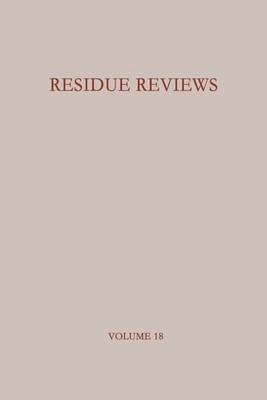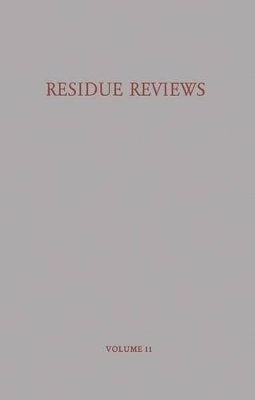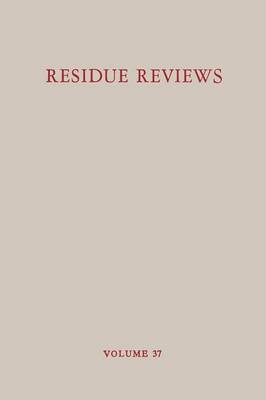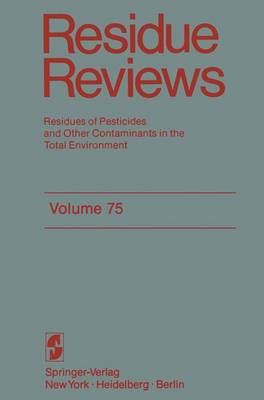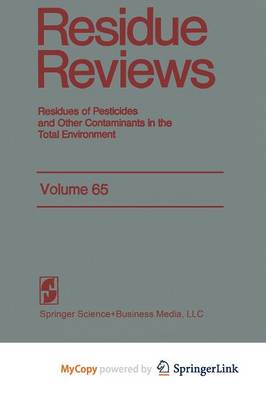Reviews of Environmental Contamination and Toxicology
7 primary works
Book 2
Book 7
Book 11
That residues of pesticide and other "foreign" chemicals in foodstuffs are of concern to everyone everywhere is amply attested by the reception accorded previous volumes of "Residue Reviews" and by the gratifying enthusiasm, sincerity, and efforts shown by all the individuals from whom manuscripts have been solicited. Despite much propaganda to the contrary, there can never be any serious question that pest-control chemicals and food- additive chemicals are essential to adequate food production, manufacture, marketing, and storage, yet without continuing surveillance and intelligent control some of those that persist in our foodstuffs could at times conceivably endanger the public health. Ensuring safety-in-use of these many chemicals is a dynamic challenge, for established ones are continually being displaced by newly developed ones more acceptable to food technologists, pharma- cologists, toxicologists, and changing pest-control requirements in progressive food-producing economies.
These matters are also of genuine concern to increasing numbers of governmental agencies and legislative bodies around the world, for some of these chemicals have resulted in a few mishaps from improper use. Adequate safety-in-use evaluations of any of these chemicals persisting into our food- stuffs are not simple matters, and they incorporate the considered judgments of many individuals highly trained in a variety of complex biological, chemical, food technological, medical, pharmacological, and toxicological disciplines.
These matters are also of genuine concern to increasing numbers of governmental agencies and legislative bodies around the world, for some of these chemicals have resulted in a few mishaps from improper use. Adequate safety-in-use evaluations of any of these chemicals persisting into our food- stuffs are not simple matters, and they incorporate the considered judgments of many individuals highly trained in a variety of complex biological, chemical, food technological, medical, pharmacological, and toxicological disciplines.
Book 37
More and more biologists, chemists, pharmacologists, toxicologists, gov ernmental agencies, and "food control" (regulatory) ofncials around the world are nnding it increasingly difncult to keep abreast of the technical literature in the pesticide neid; indeed, many libraries do not have even a small proportion of the journals and other sources that now regularly contain research, development, and application information ab out all aspects of modern chemical pest control. As a result, a very large number of requests has come to "Residue Reviews" to publish detailed digests of information on single pesticide chemicals so that the interested person in any part of the world could easily be brought up to date with all available important in formation without having to search probably several hundred literature sources, many of them obscure or simply not available except in very large libraries. The service and convenience rendered the readership by such a series of volumes on major individual pesticide chemicals would therefore be considerable. Type and scope of coverage in this series of single-pesticide volumes will oE course vary with available information. The coverage should be as com plete as possible, however, to be of maximum value to all interested indi vi duals, industries, research institutions, and governmental agencies con cerned with the continuing production of an adequately large yet safe food supply for the world. Among the topics bracketed for a single pesticide should ideally be: I. Introduction 11.
Book 70
Residues of Pesticides and Other Contaminants in the Total Environment
by Francis a Gunther
Published 1 May 1979
Book 75
Minimizing Occupational Exposure to Pesticides
by Francis a Gunther and Jane Davies Gunther
Published 9 December 1980
Worldwide concern in scientific, industrial, and governmental com munities over traces of toxic chemicals in foodstuHs and in both abiotic and biotic environments has justified the present triwnvirate of specialized publications in this field: comprehensive reviews, rapidly published progress reports, and archival documentations. These three publications are integrated and scheduled to provide in international communication the coherency essential for nonduplicative and current progress in a field as dynamic and complex as environmental contamination and toxicology. Until now there has been no journal or other publication series reserved exclusively for the diversified literature on "toxic" chemicals in our foods, our feeds, our geographical surroundings, our domestic animals, our wild life, and ourselves. Around the world immense efforts and many talents have been mobilized to technical and other evaluations of natures, locales, magnitudes, fates, and toxicology of the persisting residues of these chemicals loosed upon the world. Among the sequelae of this broad new emphasis has been an inescapable need for an articulated set of authorita tive publications where one could expect to find the latest important world literature produced by this emerging area of science together with documentation of pertinent ancillary legislation."
Book 82
That residues of pesticide and other contaminants in the total environment are of concern to everyone everywhere is attested by the reception accorded previous volumes of Residue Reviews and by the gratifying enthusiasm, sincerity, and efforts shown by all the in- dividuals from whom manuscripts have been solicited. Despite much propaganda to the contrary, there can never be any serious question that pest-control chemicals and food-additive chemicals are essential to adequate food production, manufacture, marketing, and storage, yet without continuing surveilIance and intelligent control some of those that persist in our foodstuffs could at times conceivably endanger the public health. Ensuring safety-in-use of these many chemicals is a dynamic challenge, for established ones are continually being dis- placed by newly developed ones more acceptable to food tech- nologists, pharmacologists, toxicologists, and changing pest-control requirements in progressive food-producing economies.These matters are of genuine concern to increasing numbers of governmental agencies and legislative bodies around the world, for some of these chemicals have resulted in a few mishaps from improper use. Adequate safety-in-use evaluations of any of these chemieals per- sisting into our foodstuffs are not simple matters, and they incorporate the considered judgments of many individuals highly trained in a variety of complex biological, chemical, food technologieal, medical, pharmacological, and toxicologial disciplines.
